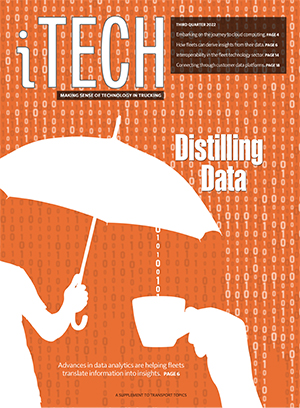Personalizing Communications With Customer Data Platforms
[Find the latest in trucking technology: Explore this quarter's issue of iTECH]
Trucking companies looking to hyperpersonalize their newsletters to customers are using new technology — enhanced customer data platforms, or CDPs — to ensure the personalized details they have on each customer are fully maximized.
“With end users being completely bombarded with an endless amount of emails, personalizing any sort of data gives you a way to stand out amongst the crowd,” said Sean Schnipper, director of marketing at Transervice Logistics.
Unlike traditional customer databases, enhanced CDPs work overtime, drawing in details about each shipper customer from multiple databases that are scattered throughout an organization — databases that used to exist as single-use, limited-access silos.

Dysart
“As a brand, you need to capture the memory of your customers as data — and then make that data available to everyone at the com pany,” said Chris Jones, chief product officer at Amperity, a provider of an enhanced CDP. “Your CDP should be the data infrastructure that not only touches every customer-facing system in your company, but delivers unified data that brings all the systems to life.”
In practice, that data can be used to hyper-personalize a newsletter by enabling a marketer to drop in many references to the company in a newsletter, instead of just one.
Going beyond a first name, for example, a hyper-personalized newsletter can also feature the recipient’s geographic location, type of freight, the name of its CEO, the number of years the customer has done business with your trucking company and the like.
Ideally, all that personalization fosters an impression with the recipient that your trucking company really knows who they’re sending that newsletter to — and highly values that relationship.
Meanwhile, maintaining in-depth data on each company also means trucking marketers can send different versions of their newsletter to different types of customers.
Your trucking company may send a custom version of your newsletter that includes an article on a discount on services to some customers, for example.
But other customers may get a different version of that newsletter that includes an article detailing new, high-end services you’re offering at an increased rate.
“Personalization allows marketing messages to stand out from the noise of general ads and catches attention by being genuinely recognizable,” said JT Peters, host of the Payload by Truck Driver Power podcast, a show targeting drivers. “We use natural language and personalization to generate interesting and addictive newsletter content that brings highly engaged subscribers back on a regular basis.”
Personalization allows marketing messages to stand out from the noise of general ads.
JT Peters, host of the Payload by Truck Driver Power podcast
Jennifer Karpus-Romain, executive director of the Transportation Marketing & Sales Association, agreed: “Hyper-personalization is definitely a way to increase relevancy and deliver very targeted messages to those who meet a certain profile — or have expressed interest in a specific topic. Just imagine what’s possible if you have eight different kinds of customers by product — or 12 kinds of prospects by industry.”
Based on that categorization, you could send eight different versions of your newsletter to different groups of customers — or 12 versions to prospects you’re looking to sell to, based on industry, she added.
Jane Jazrawy, co-founder of online driver training firm CarriersEdge, is another fan of personalized newsletters. “We send customers a monthly summary report that includes key metrics about how their drivers are using our service — along with some updates that are relevant for them.”
That personalization “increases the value of the newsletter — since it’s more focused on what the recipient is interested in,” Jazrawy added.

Jazrawy
However, there is a major caveat to consider when opting for hyper-personalization in newsletters, according to Jazrawy: You need to be sure you have an existing business relationship with a newsletter recipient before you start getting chummy with them in your messaging. Otherwise, you could easily introduce the “creep factor” into your newsletters.
For example: Companies can purchase data bundles about prospective customers from data brokers, which feature very specific metrics about those individuals across a variety of categories, Jazrawy said.
While that may sound good in theory, Jazrawy warned: “Organizations that purchase those lists and use them to create highly personalized email marketing often find that it backfires.”
“While some recipients will act on the message and purchase something, at least as many tend to be creeped out that some strange organization has so much personal detail about them,” she said. “In those situations, the personalization is more harmful than helpful.”
Not surprisingly, there are some in the trucking industry that simply avoid personalization altogether for that reason.

In this special edition of RoadSigns, hosts Seth Clevenger and Mike Freeze provide an inside look at Transport Topics' 2022 Top 100 Private Carriers list. Tune in above or by going to RoadSigns.ttnews.com.
“We don’t use any personalization in the newsletters other than first name,” said Bruce Outridge, host of The Lead Pedal Podcast. “We want people to view our information without worrying about data.”
Even so, those who do see real value in hyper-personalizing will find that CDP software makers have been working in overdrive ensuring their software vacuums in data from as many sources as possible.
A best-of-breed, all-seeing CDP, for example, can automatically import personal details about customers as they interact with your trucking business by email, chat, text, phone, social media, clicks in newsletters, clicks on websites, in person, and virtually every form of customer interaction that is either digital or can be digitized.
Meanwhile, aggressive users of CDPs are also continually experimenting with ever-more novel ways to import ever-more data insights about customers. Those include tasking trusted reps to add their own insights about customers to your CDP as they interact with them.
And they’re also encouraging customers to fill out detailed profiles about themselves in exchange for a chance to win a gift card.
The most skilled users of CDPs also go beyond mere personalization to study reports generated by best-of-breed software that shows them which customers are responding most favorably to their hyper-personalized newsletters, which customers have made purchases after viewing videos embedded in those newsletters, and which customers have made purchases after they read a detailed, long-form article on their products or services.
And those reports are just for starters.

Q3 iTECH
►Advances in Analytics Help Fleets Translate Information Into Action
►Connected Workflows Can Lead to a Higher Level of Operational Fitness
►Dysart: Personalizing Communications With Customer Data Platforms
►Clevenger: Mapping the Journey to Cloud Computing
Explore the Issue!
Essentially, once trucking marketers amass a hyper-detailed, continually evolving, all-seeing view of each customer, they can use the AI analytics provided by CDP software to ask as many questions as they’d like about that data, from virtually every perspective.
In a phrase, trucking marketers armed with AI-powered CDPs have a perpetual-motion marketing machine.
Take Accenture’s Consumer 360 platform, for example. Using Accenture’s CDP, a manufacturer was able to stream data from 35 different databases scattered across its organization into a single master database. That capability enabled marketers there to analyze what videos a customer viewed on their products, what that customer said about the company’s products on social media, what retailers the customer visited online to learn more about the product and how that same customer interacted with marketing for those products.
Consequently, based on those insights, the manufacturer was able to use the Consumer 360 platform to predict when that customer would make a purchase, along with the specific product he or she would most likely buy.
For the company that used the Consumer 360 Platform in this way, customer engagement with company marketing materials jumped 25% and average revenue earned per visit shot up 10%, according to Accenture.
Meanwhile, Adobe — another provider of enhanced CDPs — has a handy checklist you can use when shopping for the ultimate CDP solution. Here’s Adobe’s take on the top features to look for in any CDP:
- Real-time data streaming and data ingestion: For maximum efficacy, ensure that the database consolidation you use offers real-time updates from all data streams you’re sourcing.
- Purpose-built as a CDP by a trusted organization: Many CDPs in the marketplace are cobbled together from disparate technologies. Make sure you choose a solution from a company that built the CDP from the ground up.
- Complete, unified user profiles: One of the principal benefits of a CDP is personalization on an individual basis.
- Robust, native data governance tools: Your CDP should make your data governance simpler, not more complex.
- Real-time data activation: Ensure that any data you use for newsletter personalization is always the latest available.
- Easy for marketers to use: CDPs democratize data. An ideal CDP has an interface, tools and workflows structured to work seamlessly with marketing departments.
- Scalable, flexible and extensible: Your CDP should integrate seamlessly with your existing marketing and advertising technology stack without putting extra strain on IT.
Joe Dysart is an internet speaker and business consultant based in Manhattan. Voice: (631) 438-1142. Email: joe@gurutechalert.com
Want more news? Listen to today's daily briefing below or go here for more info:




